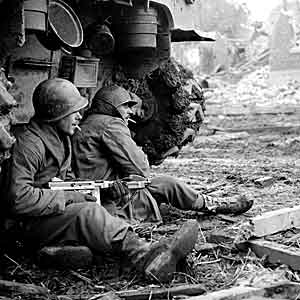

 |
Stories from the frontlines and the home front make up Burns' new series. Pictured: Soldiers smoking beside a tank in Germany, Dec. 11, 1944. (Photo: National Archives.) |
|---|
Originally published in Current, June 26, 2006
By Theodore Fischer
The War, Ken Burns’ series about the American experience in World War II, will invade PBS stations nationwide in fall 2007. But instead of ponderous interviews with generals and diagrams of troop movements typical of earlier WWII docs, the seven-part, 14-hour series will focus on the grunts on the ground and the gals (and others) they left behind in four quintessential American localities — Mobile, Ala.; Sacramento, Calif.; Waterbury, Conn.; and Luverne, Minn.
The producers chose towns to provide both variety and a cross-section of American types akin to the G.I. platoons of old World War II flicks.
Mobile was the hometown of Eugene Sledge, author of a powerful war memoir (With the Old Breed: At Okinawa and Peleliu). The major shipbuilding center in the segregated South was also a good place to examine home-front race relations during the war boom. Sacramento had a large Japanese-American population—many of whom were locked up for the duration—plus military bases and weapons factories.
Waterbury, then the brass capital of the world, boasted a hard-working immigrant population, mostly Italian- and Irish-Americans, who kept plants running 24/7. And Luverne was the rural hometown of Quentin C. Aanenson, whose exploits inspired the 1993 PBS documentary A Fighter Pilot’s Story.
Portions of the series were screened this month at the American Film Institute Silverdocs Festival in Silver Spring, Md., as well as at the PBS Showcase Conference in May.
A production of Burns’ Florentine Films and Washington’s WETA and co-directed/produced by Burns and Lynn Novick, The War mingles familiar Burns elements with some deliberate departures. Geoffrey C. Ward, the writer on most Burns productions, wrote the script. Wynton Marsalis, senior creative consultant for Burns’ Jazz, composed, arranged and performed the music. Keith David’s memorable narration is augmented by celebrity voices, such as Tom Hanks, who reads moving accounts of home-front life from Luverne newspaper columns.
This time around, however, talking heads will be limited to eyewitness testimony, even though the eyewitnesses are thinning rapidly (the Department of Veterans Affairs estimates that 1,000 World War II veterans die every day).
"We didn’t interview any historians, only people who lived through that period,” says Sarah Botstein, a producer with the series. “And we didn’t interview generals. We wanted it to be about the guys who were on the ground fighting the war—particularly people who saw serious combat.”
The War will also be markedly noisier than previous Burns films. “We’re using surround sound, we’re mixing in a digital environment, and on top of that we’re adding explosion upon explosion,” says Novick. “The sound will make the film much more nuanced, much more detailed, very intense both emotionally and neurologically.”
With funding from General Motors, Anheuser Busch, CPB and the Lilly and Arthur Vining Davis foundations, among others, production of The War has lasted somewhat longer than U.S. involvement in the war.
“We’ve been working on this film for a little over five years,” says Botstein. “The first year or so we did basic research—meeting people who spent their lives studying the subject, putting together a board of advisors, and figuring out our narrative. We spent 2½ years meeting veterans from all over the country—we spoke with probably 550 to get the 40 or 50 we interviewed—and deciding on the four towns and who in those towns we would interview.”
The crew spent the next two years combing archives, submissions by historical societies and material unearthed by a newspaper outreach campaign. “We asked people to go into their attics—literally—and find 8mm or sometimes 16mm home movies,” says Botstein. “That’s what makes this film unlike any film we’ve ever done. This is the richest archival event in history.”
Their quest was footage that, according to Novick, looked beyond “the World War II’s Greatest Hits you see on the History Channel every night,” says Novick. “For example, a lot of the footage you’ve seen of D-Day was actually taken at rehearsals. It’s incredibly dramatic ... but it’s a rehearsal. We use only footage taken at the event.”
The film itself juxtaposes home movies and other archival material with war news. In one poignant sequence, the voiceover accompanying clips—in color—of a young soldier’s wedding contrasts with battles taking place that day in what seems like an alternate universe. “Whenever we found color, we tried to work it in,” says Novick.
The long lead time also lets Burns’ team juggle multiple projects. “Different teams of producers are working on different projects, and part of Ken’s genius is that he’s really able to understand more than one subject,” says Botstein. “The films are always in a different stage of production, so one film is in pre-production while another is editing.” Next up is the five-part, 10-hour America’s Best Idea: Our National Parks, followed by Forbidden Fruit: America During Prohibition.
And that will be followed by? “Nothing yet,” says Botstein. “Parks and Prohibition will take us through 2010, so we’ve got a way to go.”
Web page
posted Oct. 27, 2006
Copyright 2006 by Current Publishing Committee